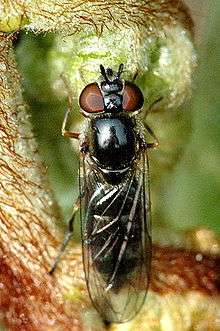Platycheirus clypeatus
Platycheirus clypeatus is a species of hoverfly. It is found across the Palearctic and in the Nearctic. The larvae feed on aphids. Adults are usually found on the edges of woodland or scrub, heath or along hedgerows where they visit a wide range of flowers.[1][2][3][4]
| Platycheirus clypeatus | |
|---|---|
 | |
| Platycheirus clypeatus female | |
| Scientific classification | |
| Kingdom: | |
| Phylum: | |
| Class: | |
| Order: | |
| Family: | |
| Genus: | |
| Subgenus: | Platycheirus |
| Species: | P. clypeatus |
| Binomial name | |
| Platycheirus clypeatus (Meigen, 1822) | |
| Synonyms | |
| |
Description
External images
Femorae 1 has posterior hairs extending almost to apex. Tarsae 1 and 2 are orange. Face has eye margins almost parallel from level of antennal insertions to the lower margin of facial prominence.
For unknown terms, see: Morphology of Diptera.
See references for determination.[5][6][7][8]
[9]
Distribution
Palearctic: Fennoscandia south to Iberia and the Mediterranean basin, Ireland east through Europe into Turkey and European Russia and then from the Urals to central Siberia. Nearctic: Alaska to Ontario and south to California.[10][11][12]
Biology
Habitat: grassland and fen, margins of ponds, streams, bogs and lakes, wet ditches and canals. It flies April to September. [4]
References
- Ball, Stuart; Morris, Roger (2013). Britain's Hoverflies: An Introduction to the Hoverflies of Britain. Woodstock, Oxfordshire: Princeton University Press. pp. 296pp. ISBN 978-0-691-15659-0.
- Stubbs, Alan E. & Falk, Steven J. (1983). British Hoverflies: An Illustrated Identification Guide. British Entomological & Natural History Society. pp. 253, xvpp.
- Van Veen, M. (2004) Hoverflies of Northwest Europe: identification keys to the Syrphidae. 256pp. KNNV Publishing, Utrecht.addendum
- Speight, M.C.D. (2011). "Species accounts of European Syrphidae (Diptera)" (PDF). Syrph the Net, the database of European Syrphidae. 65: 285pp.
- Van Veen, M. (2004). Hoverflies of Northwest Europe: identification keys to the Syrphidae. 256pp. KNNV Publishing, Utrecht.addendum.
- Van der Goot, V.S. (1981). De zweefvliegen van Noordwest - Europa en Europees Rusland, in het bijzonder van de Benelux. KNNV, Uitgave no. 32: 275pp. Amsterdam.
- Bei-Bienko, G.Y. & Steyskal, G.C. (1988). Keys to the Insects of the European Part of the USSR, Volume V: Diptera and Siphonaptera, Part I. Amerind Publishing Co., New Delhi. ISBN 81-205-0080-6.
- Coe, R.L. (1953). "Diptera: Syrphidae". Handbks. Ident. Br. Insects 10(1): 1-98. R. Ent. Soc. London. pdf.
- Speight, M.C.D. & Goeldlin de Tiefenau, P. (1990). "Keys to distinguish Platycheirus angustipes, P. europaeus, P. occultus and P. ramsarensis (Dipt., Syrphidae) from other clypeatus group species known in Europe". Dipterists Digest 5: 5-18.
- Fauna Europaea.
- Peck, L.V. (1988). "Syrphidae". In: Soos, A. & Papp, L. (eds.). Catalogue of Palaearctic Diptera 8: 11-230. Akad. Kiado, Budapest.
- Vockeroth, J.R. (1992). The Flower Flies of the Subfamily Syrphinae of Canada, Alaska, and Greenland (Diptera: Syrphidae). Part 18. The Insects and Arachnids of Canada. Ottawa, Ontario: Canadian Government Pub Centre. pp. 1–456. ISBN 0-660-13830-1.